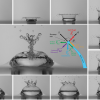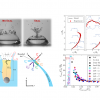Description
The data provided in this publication was used to deliver the first detailed mechanical analysis of splash curtain, providing a physical understanding on why the splash curtain sometimes seals, and other times it does not.
When an object impacts the free surface of a liquid, it ejects a splash curtain upwards and creates an air cavity below the free surface. As the object descends into the liquid, the air cavity eventually closes under the action of hydrostatic pressure (deep seal). In contrast, the surface curtain may splash outwards or dome over and close, creating a surface seal. We experimentally investigate how the splash curtain dynamics are governed by the interplay of cavity pressure difference, gravity, and surface tension and how they control the occurrence, or not, of surface seal. Based on the experimental observations and measurements, we develop an analytical model to describe the trajectory and dynamics of the splash curtain. The model enables us to reveal the scaling relationship for the dimensionless surface seal time and discover the existence of a critical dimensionless number that predicts the occurrence of surface seal. This scaling indicates that the most significant parameter governing the occurrence of surface seal is the velocity of the airflow rushing into the cavity. This is in contrast to the current understanding which considers the impact velocity as the determinant parameter.
Cite this work
Researchers should cite this work as follows:
- Eshraghi, J.; Jung, S.; Vlachos, P. (2021). To Seal or Not To Seal: Study of Splashes. Purdue University Research Repository. doi:10.4231/JQ7R-YS20
Tags
Notes
The dataset can be more easily accessed through the ftp protocol as file 10_4231_JQ7R-YS20.zip on the PURR's FTP server. For instructions how to access the zip file, see https://purr.purdue.edu/kb/projects/access-datasets-using-ftp-client.

